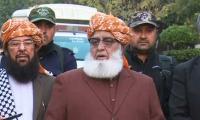In my occasional encounters with college students, over the years, I would sometimes assign them a project: make your own portrait of Pakistan and then reflect on your personal relationship with this country. Usually, this invitation would not stir any great enthusiasm. In fact, most of our educated young persons are not able to comprehend the reality of Pakistan in terms of some basic facts about it.
But how does one make a portrait of Pakistan? I know that this can also be a very subjective exercise. However, my stress would be on a tabulation of its principal economic, social and cultural indicators to try to determine its place in the region and the world. Among questions raised would be whether it is making progress and if it is headed in the right direction as a modern democracy.
Incidentally, we dabble in these matters every Independence Day, which we celebrated on Friday, in a ritualistic manner. At the popular level, the occasion brings considerable cheer and excitement. The green flags are much in evidence. In Karachi, they flocked to the Sea View like they do on Eid and New Year’s Eve. Even in the midst of the pandemic, the celebration was largely unrestrained.
Yes, we cannot escape the sceptre of the coronavirus pandemic, though we have found some respite from it. We have celebrated our Independence Day in a new world, throbbing with an incomprehensible sense of dread and uncertainly. In this environment, we would be expected to be more thoughtful about our prospects.
Somehow, Pakistan has perennially wandered in a state of crisis. Some factors have enhanced this feeling at this time. Maryam Nawaz has staged a sort of a comeback and pepped up the political atmosphere. Ominous moves to change the status of Karachi are said to be under the consideration of the federal authorities, promising a political conflagration. We can hear the distant drums of what has happened in the domain of the foreign affairs.
In these circumstances, our concerns about the evolving state of affairs will outlast the perfunctory functions of the Independence Day. Perhaps the portrait of Pakistan would need to be dabbed a little with a dark brush. I would hesitate to recount my own observations as a journalist and as a human rights defender. The regression we have suffered in every sector of our society is rising like a wave.
So much so that the Single National Curriculum (SNC) that was expected to mainstream the madressah seems intended to achieve the reverse of it. This is not a scheme that would reduce inequality and inequity in education. Critical thinking is being suppressed in the name of religion and nationalism.
My young interlocutors could start their factsheet with some obvious facts. For instance, we are in the front row of the world in terms of our population, our nuclear capability, and the size of our standing army. But there is also that Human Development Index (HDI) of UNDP, designed by our own Dr Mahbubul Haq. On this index, we are currently placed at 152 out of 189 countries.
It is instructive, in the context of the present conversation, that Bangladesh is lodged so much ahead of us, at 135. How did it happen? This would be a crucial comparison when we seek to determine Pakistan’s place in the world. When East Pakistan became Bangladesh in December 1971, it was also called a basket case. Now, only look at how much a dollar would cost in Pakistan and in Bangladesh.
We have a host of surveys and listings methodically compiled by international institutions. In almost every such assessment, across a very wide spectrum, we come out very poorly. The pity of it is that we have declined in recent years and are now at the bottom of South Asia.
Once I thought of compiling a list of the titles of books about Pakistan penned by prominent Pakistanis and writers sympathetic to Pakistan, including memoirs and biographies. I wanted to see the picture that this list would draw. But I did not feel encouraged to complete the task.
There are some books that we need to read to help us better understand our beloved country. Friend Babar Ayaz has put it directly: ‘What’s Wrong with Pakistan?’ Historian Farzana Shaikh has written in the same vein: ‘Making Sense of Pakistan’. There are several other books that I could recommend. I have been doing so to some of my young friends but, sadly, they are not very interested.
The silver lining here is that foreigners who have lived in Pakistan for a stretch of time as diplomats and officials of international institutions carry fond memories of their stay in Pakistan and this is reflected in their writings, if they happen to do so. I would also include foreign correspondents who have covered Pakistan in this category though newspersons find little to applaud when they cover politics and governance in Pakistan. Still, the warmth and the hospitality of the people they interact with cannot easily be forgotten. I have often been told by foreigners that Pakistanis are about the most wonderful people in the world.
This makes me eager to read Declan Walsh’s ‘The Nine Lives of Pakistan: Dispatches from a Precarious State’. He is the former bureau chief of The New York Times in Pakistan and has many good friends in Pakistan. The book has been released and should be available in Pakistan in a few days. It tells the story of nine Pakistanis “who lived, and often died, through the dramas of recent decades”.
I am not surprised that Declan Walsh’s personal story of Pakistan had a sad ending. Read this tweet he posted this week: “One night seven years ago, I returned to my home in Islamabad to find security agents at my door. They handed me an expulsion letter and gave me 72 hours to leave. I was stunned. I was in Pakistan for a decade. I couldn’t figure out what I had done”.
Ah, but it is easy to figure out what a journalist would do.
The writer is a senior journalist.
Email: ghazi_salahuddin@hotmail.com
Key actors in global power politics are US, China, Russia, European Union, and emerging powers such as India and Brazil
Maulana Fazl manages to bring together factions that historically stand opposed
NASA says August 2024 set new monthly temperature record, capping Earth’s hottest summer since 1880
To take part in revolution, farmers need resources to afford seed varieties, fertilisers, and cost of setting up tube...
Pakistan remains burdened by insufficient financial support, saddled with conditions that deepen dependency
Government implements key policy decisions aimed at stabilising the economy







